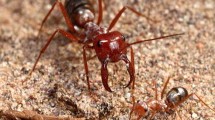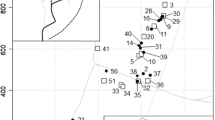Abstract
Genetic influences on polyethism within social insect colonies are well known, suggesting that the determination of caste (soldiers and minor workers) may also be genetically mediated. The Australian sugar ant Camponotus consobrinus is suitable for such a study, having soldiers and minor workers that follow a complex allometry. Further, although most C. consobrinus colonies are monogynous, 13 of 42 surveyed using microsatellites were found to be polygynous. Thus, although a minority of colonies were polygynous, the great majority of queens live in polygynous colonies. From the 29 monogynous colonies studied, we inferred that the queens are monandrous. Ants from four polygynous colonies were assigned to families on the basis of microsatellite genotypes, after measurements had been taken of head width and scape length. These measurements reflect a complex allometry interpretable as soldier and minor worker growth curves with a large changeover zone. Genetic influence on caste determination was examined by testing for differences between families within colonies in the distribution of scape lengths, residuals from the overall colony allometric curve, and proportions of soldiers and minor workers (as determined by head width falling above or below the inflection point of the overall colony allometric curve). Families in all four colonies differed significantly in caste proportions and in head-width distributions, and three of the four colonies showed significant differences between families in residuals from the overall colony growth curve. Nested ANOVAs using head widths and scape-length residuals showed that when the effect of family is removed, intercolony differences in allometry are negligible. This evidence indicates genetic rather than environmental causes for the observed differences between families. We speculate that this variation may reflect some selective advantage to within-colony heterogeneity between families or that selective differences are few between a wide array of family growth patterns.
Similar content being viewed by others
Author information
Authors and Affiliations
Additional information
Received: 16 June 1999 / Received after revision: 13 September 1999 / Accepted: 25 September 1999
Rights and permissions
About this article
Cite this article
Fraser, V., Kaufmann, B., Oldroyd, B. et al. Genetic influence on caste in the ant Camponotus consobrinus . Behav Ecol Sociobiol 47, 188–194 (2000). https://doi.org/10.1007/s002650050010
Issue Date:
DOI: https://doi.org/10.1007/s002650050010




